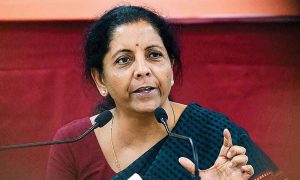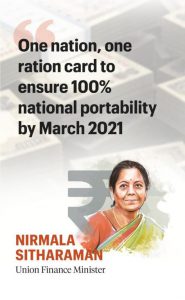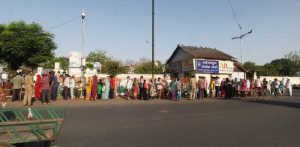MAY 14, 2020
According to Finance Minister Nirmala Sitharaman, the ‘One Nation One Ration Card’ system will enable migrant workers and their family members to access PDS benefits from any Fair Price Shop in the country.

Union Finance Minister Nirmala Sitharaman addresses the press in New Delhi on Thursday. (Express Photo: Anil Sharma)
Finance Minister Nirmala Sitharaman on Thursday announced the national rollout of a ‘One Nation, One Ration Card’ system in all states and Union Territories by March 2021. As of now, about 20 states have come on board to implement the inter-state ration card portability.
According to the Finance Minister, this system will enable migrant workers and their family members to access PDS benefits from any Fair Price Shop in the country.
What is the one ‘One Nation, One Ration Card’ system?
Under the National Food Security Act, 2013, about 81 crore persons are entitled to buy subsidized foodgrain — rice at Rs 3/kg, wheat at Rs 2/kg, and coarse grains at Re 1/kg — from their designated Fair Price Shops (FPS) of the Targeted Public Distribution System (TPDS).
Currently, about 23 crore ration cards have been issued to nearly 80 crore beneficiaries of NFSA in all states and UTs.

In the present system, a ration cardholder can buy foodgrains only from an FPS that has been assigned to her in the locality in which she lives. However, this will change once the ‘One Nation, One Ration Card’ system becomes operational nationally. This is how it will work:
Suppose a beneficiary lives in the district of Basti in Uttar Pradesh and migrates to Mumbai for work. Currently, she is no longer able to purchase subsidised foodgrains from a PDS shop in her new locality in Mumbai. However, under the ‘One Nation, One Ration Card’ system, the beneficiary will be able to buy subsidised foodgrains from any FPS across the country.
The new system, based on a technological solution, will identify a beneficiary through biometric authentication on electronic Point of Sale (ePoS) devices installed at the FPSs, and enable that person to purchase the quantity of foodgrains to which she is entitled under the NFSA.
How will the system of ration card portability work?
Ration card portability is aimed at providing intra-state as well as inter-state portability of ration cards.
While the Integrated Management of Public Distribution System (IM-PDS) portal (http://www.impds.nic.in/) provides the technological platform for the inter-state portability of ration cards, enabling a migrant worker to buy foodgrains from any FPS across the country, the other portal (annavitran.nic.in) hosts the data of distribution of foodgrains through E-PoS devices within a state.
The Annavitran portal enables a migrant worker or his family to avail the benefits of PDS outside their district but within their state. While a person can buy her share of foodgrains as per her entitlement under the NFSA, wherever she is based, the rest of her family members can purchase subsidized food grains from their ration dealer back home.

Finance Minister Nirmala Sitharaman announced the national rollout of a ‘One Nation, One Ration Card’ system in all states and Union Territories by March 2020. (Express Photo: Anil Sharma)
Since when has the One Nation, One Ration Card System been in the works?
Work on this ambitious project started about two years back when the government launched a scheme called Integrated Management of Public Distribution System (IM-PDS) in April 2018 to reform the public distribution system in the country.
The PDS system was marred with inefficiency leading to leakages in the system. To plug the leakages and make the system better, the government started the reform process.
For, this purpose it used a technological solution involving the use of Aadhaar to identify beneficiaries. Under the scheme, the seeding of ration cards with Aadhaar is being done.
Simultaneously, PoS machines are being installed at all FPSs across the country. Once 100 per cent of Aadhaar seeding and 100 per cent installation of PoS devices is achieved, the national portability of ration cards will become a reality.
It will enable migrant workers to buy foodgrains from any FPS by using their existing/same ration card.

People line up outside a PDS outlet in the Behrampur area of Ahmedabad as the Gujarat government distributes free ration amid the nationwide lockdown due to COVID-19. (Express Photo: Javed Raja)
How many states have come on board to roll out inter-state portability of ration cards?
It was initially proposed to nationally rollout the ‘One Nation, One Ration Card’ scheme by June 1, 2020.
So far, 17 states and UTs — Andhra Pradesh, Goa, Gujarat, Haryana, Jharkhand, Kerala, Karnataka, Madhya Pradesh, Maharashtra, Rajasthan, Telangana, Tripura, Uttar Pradesh, Bihar, Punjab, Himachal Pradesh, and Dadra & Nagar Haveli and Daman & Diu — have come on board to roll out the inter-state portability of ration cards under the NFSA.
Three more states — Odisha, Mizoram, and Nagaland — are expected to come on board by June 1, taking the number of States and UTs to 20 under the One Nation, Once Ration Card System.
How has been the experience of Ration Card Portability so far?
The facility of inter-state ration card portability is available in 20 states as of now but the number of transactions done through using this facility has been low so far.
According to data available on the IMPDS portal, only 275 transactions have been done until May 14. However, the number of transactions in intra-state ration card portability is quite high.
The data available on the Annavitaran portal shows that about one crore transactions took place using the facility last month. It means that usages of intra-state ration card portability are way higher than the inter-state portability.
Courtesy/Source: Indian Express










































































































